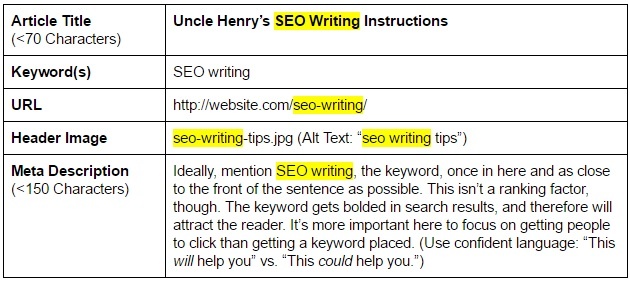Uncle Henry’s SEO Copy Writing Guidelines



In my experience, writers don’t usually care about SEO. That’s a stereotype, yes... but it’s also a compliment. It’s the writer’s job to focus on writing helpful, insightful, interesting content—not to shove a bunch of awkwardly worded search phrases into a paragraph.
But even with that in mind, a marketing team still needs to give each article a fighting chance to rank in Google’s search results. That’s where SEOs (search engine optimizers) and writers overlap (and often argue). SEOs would probably call it “on-page SEO,” and writers might call it SEO copy writing.
So here’s the exact on-page SEO guidelines I give to Necta writers. In the sample article below, you’ll see where I recommend using keywords (they’ll be highlighted), plus you’ll get some insider SEO tips.

Introduction: Mention the keyword, SEO writing, once in the introduction. Google wants to see the keyword as close to the top of the article as possible. If it doesn’t work, and it feels like you’re stuffing it in there, just go ahead and skip it. It’s much more important to write for your readers than it is to write for Google.
<h2>Make sure you mention the keyword, SEO writing, in a header.</h2>
Related keywords: Throughout the content, use related phrases like “SEO blogging” or “search engine optimization.” Google makes connections between grammatically related phrases and similar keywords, so spread around the love. (It’s technically called “latent semantic indexing” in case you were wondering. This goes back to the idea of writing for humans, not search engines.)
With Google’s ability to make these connections between related terms, it makes it a lot easier to rank for a number of keywords with just one article. For example, if you choose to do your own article on “SEO writing,” naturally work in some synonyms like “content” and “copy writing,” and you’ll be in a good spot for Google to view this article for a number of related topics.
Don’t stuff the keyword (in this case, “SEO writing”) into the content. It doesn’t seem like Google has a minimum number of mentions they are looking for anymore, but I firmly believe they do have a maximum. A good rule of thumb is to keep your usage of the keyword phrase below 2% of the total content. If your article is 800 words, I recommend mentioning the phrase no more than eight times (1%).
If you want to get geeky for a second, this concept is known as “keyword density.” It’s an outdated (at worst) and altogether mythical (at best) concept about what Google wants to see for this percentage. So like I said, stick to writing for humans around the helpful topic you’ve chosen, and you should be good in this department.
Link out to other articles that are related, both on your site and on other sites. Mention a keyword in the anchor text like “SEO tips from Waldo,” but definitely don’t overdo it. It’s OK to link like this, or like this occasionally, too:
See Also: How To Be An Expert SEO Copy Writer
Social sharing: Encourage shares of the article—maybe by mentioning certain experts or simply by asking for shares. Google relies on social links more and more every year.
Calls to action (CTA): This isn't as important for SEO, but it is important for converting readers into leads once they get to your website. Make sure to include a designed CTA at the bottom of the post (like you see), but also an H3 CTA. Those work really well. Here's an example.
Conclusion: Keep in mind that we’re trending toward keywords dying on the whole. Google really wants to provide the best content for topics, not for keywords. That’s why they’ve done a ton of work to try to make connections between related terms. If you search “SEO writing tips” and “SEO content tips,” Google knows those are the same thing. Think about writing a great article about a certain topic or concept, and Google will find you.

